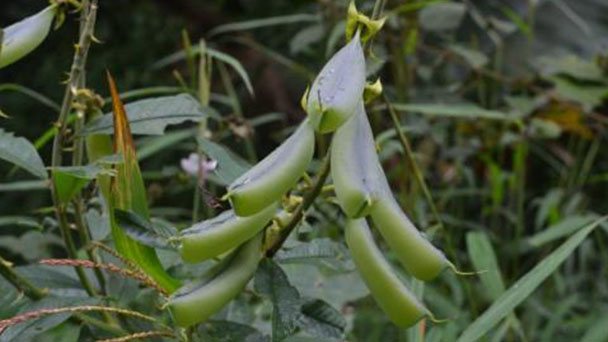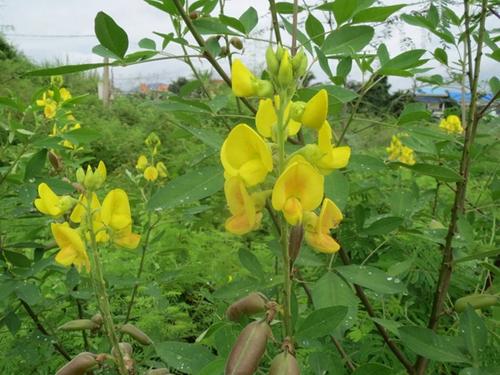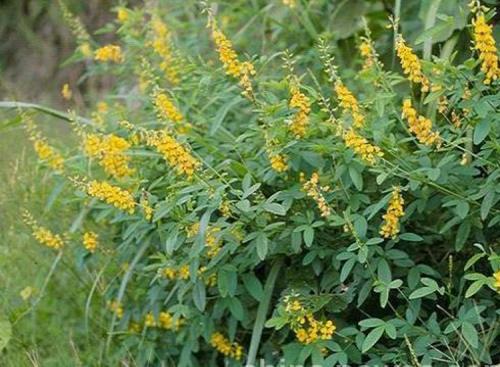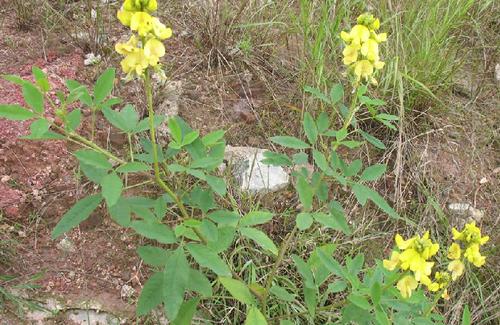Crotalaria pallida (smooth rattlebox) profile
Written by Maggie
Mar 17 2021

Crotalaria pallida, also called pikakan, salts rattlebox. smooth crotalaria, smooth rattlepod, striped crotalaria, is a perennial herb or erect dwarf shrub of the leguminous family. Stem branches are pubescent. Crotalaria pallida is a very resilient plant that can grow on riverbeds, banks, under the hot sun, and in sandy and gravel environments.
The whole grass and root of crotalaria pallida plant can be used for medicinal purposes. The whole grass has the functions of dispersing and clearing moisture and heat. Modern clinical trials in the anti-tumor effect are good, mainly for squamous cell carcinoma, basal cell carcinoma is effective. In addition, it can also be used as a garden plant and green manure plant. However, the seeds and young branches of Crotalaria Pallida are poisonous. People and animals eat the seeds or stems by accident, and in severe cases, death can result from loss of ascites and liver function.
Crotalaria pallida picture

Morphological characteristics of Crotalaria pallida
Crotalaria pallida is a perennial or shrubby herb; Stem branches are cylindrical, with small grooves, densely compactively pubescent. Stipules are very minute, setose, usually caducous; Leaves are 3-emerald, stalks 2-4 cm long; Leaflets are oblong or elliptic, 3-6 cm long and 1.5-3 cm wide, apex obtuse or concave, base broadly cuneate, glabrous above, slightly mercurous pubescent below, veins distinct on both surfaces; Petioles are 1 -- 2 mm long.
Crotalaria pallida terminal racemes, up to 25 cm long, with 10-40 flowers; Bracts are linear, ca. 4 mm long; Caducous, bracteoles similar in shape to bracts, ca. 2 mm long, very minute when flowering, less than 1 mm long, central or base of calyx tube; Pedicels are 3 -- 5 mm long; Calyx is subcampanulate, 4 -- 6 mm long, five-lobed, calyx teeth triangular, ca. As long as calyx tube, densely pubescent; Corolla of Crotalaria pallida is yellow, extending beyond calyx, flagvalve orbicular or elliptic, ca. 10 mm in diam., base with 2 corpus callosum, pectoralis oblong, ca. 8 mm long, lower margin pilose, keel longest, ca. 12 mm, curved, up to 90 degrees, long beak, base margin pilose; Ovary is sessile. Pod is oblong, 3-4 cm long, 5-8 mm in diameter, hairy when young, shed at maturity, petal dehiscent and then torsion; Crotalaria pallida has 20-30 seeds.
Ecological habits of Crotalaria pallida
Crotalaria pallida is a resilient plant that grows on riverbeds, along banks, in the hot sun, and in sandy, gravel environments. In such a land, there is not much soil, nature does not have too many nutrients;In the absence of shade coverage, the temperature and humidity change dramatically with the change of weather. The sun burns very hot on sunny days and the cold wave is the first to hit, but Crotalaria Pallida can still grow normally.
Crotalaria pallida cultivation
Crotalaria pallida is a plant of the lowland tropics and subtropics, the place it has been correctly grown at elevations up to 1,800 metres. It grows in a vast variety of annual rainfall conditions, from 850 mm to over 3,000 mm, and takes place from time to time in instead dry locations. The common annual temperature varies from sixteen - 26°c. Succeeds on an extensive variety of soils, besides on peat soils that developed below coarse grass. Crotalaria pallida is viewed properly acceptable to sandy soils and has succeeded in saline stipulations in Thailand. It requires a sunny position, developing poorly in shade. Often grown as an inexperienced manure, Crotalaria pallida can get away from cultivation and end up naturalized. It is pronounced to be invasive in many areas, the place it grows in open and disturbed websites such as pastures, waste ground, roadsides and sand dunes at elevations up to 1,070 metres.
Crotalaria pallida has a symbiotic relationship with positive soil bacteria, these microorganism shape nodules on the roots and repair atmospheric nitrogen. Some of this nitrogen is utilized by way of the developing plant however some can additionally be used through different flowers developing nearby.

Species taxonomy of Crotalaria pallida
Related to the type of Crotalaria pallida: Crotalaria pallida (Crotalaria lanceolataE. MEY.), Crotalaria pallida (Crotalaria ochroleucag.don), Calyx Crotalaria pallida (Crotalaria zanzibaricaBenth.).
The distribution of Crotalaria pallida
Crotalaria pallida is grown in Fujian, Taiwan, Guangdong, Guangxi, Sichuan, Yunnan, Shandong, Zhejiang and Hunan.
Crotalaria pallida grows in barren mountain grasslands and sandy soils at altitudes of 100-1000 meters.Distribution to the Americas, Africa, Asia tropical, subtropical areas.
The use of Crotalaria pallida
Greening effect
Galactomannan gum is also found in the seeds of this genus and is widely used in petroleum, mining, textile and food industries. Because Crotalaria pallida likes to grow in sandy soil, it is a good water and soil conservation plant. Many species are common green manure and mulch plants in the tropics and subtropics.
Medical role
Pyrrolizidine alkaloids derived from Crotalaria pallida have strong biological activity. Many kinds of plants can be used for medicine, such as clearing away heat and detoxification, dispelling wind and dehumidification, reducing swelling and relieving pain, and treating rheumatic paralysis, scabies and injuries. In recent years, Crotalaria pallida has been used for anti-cancer treatment, mainly for squamous cell carcinoma, basal cell carcinoma, acute leukemia, cervical cancer and penile cancer. In some provinces and regions of China, seeds of Crotalaria pallida are used instead of tribulus terrestris, which should be corrected.

Latest Updated
- Benefits of Bugleweed - 7 Science-backed Health Benefits
- Bugleweed Dangers & Side Effects - Is It Poisonous?
- How to Plant Evergreen Trees - What You Should Know
- When to Plant Evergreens - Grow Guide for Evergreen Trees
- 12 Wonderful Evergreen Shrubs for Your Garden
- 12 Popular Evergreen Plants with Pictures for Beginners
- When And How To Prune A Lilac Bush Like a Pro
- How to Grow & Care for Lilac Vine (Hardenbergia Violacea)
- Japanese Lilac Tree (Syringa Reticulata) Care & Propagation Guide
- Shumard Oak Pros and Cons - What to Know
Popular Articles
- Winter maintenance of Antirrhinum Majus
- How to Grow Terminalia Mantaly Tree
- How to Grow and Care for Crossostephium Chinense
- How to grow Antirrhinum Majus in spring
- Peristeria Elata (Dove Orchid) Profile: Info & Care Guide
- Underwatered Snake Plant (Sansevieria Trifasciata) - Signs And How To Fix
- How to Care for Brazilian Jasmine Plant (Mandevilla Sanderi)
- How to Grow & Care for Graptopetalum Purple Delight in Summer
- Rosa Chinensis (China Rose): Plant Growing & Care Tips
- How to Care for Baby Sun Rose (Aptenia Cordifolia)